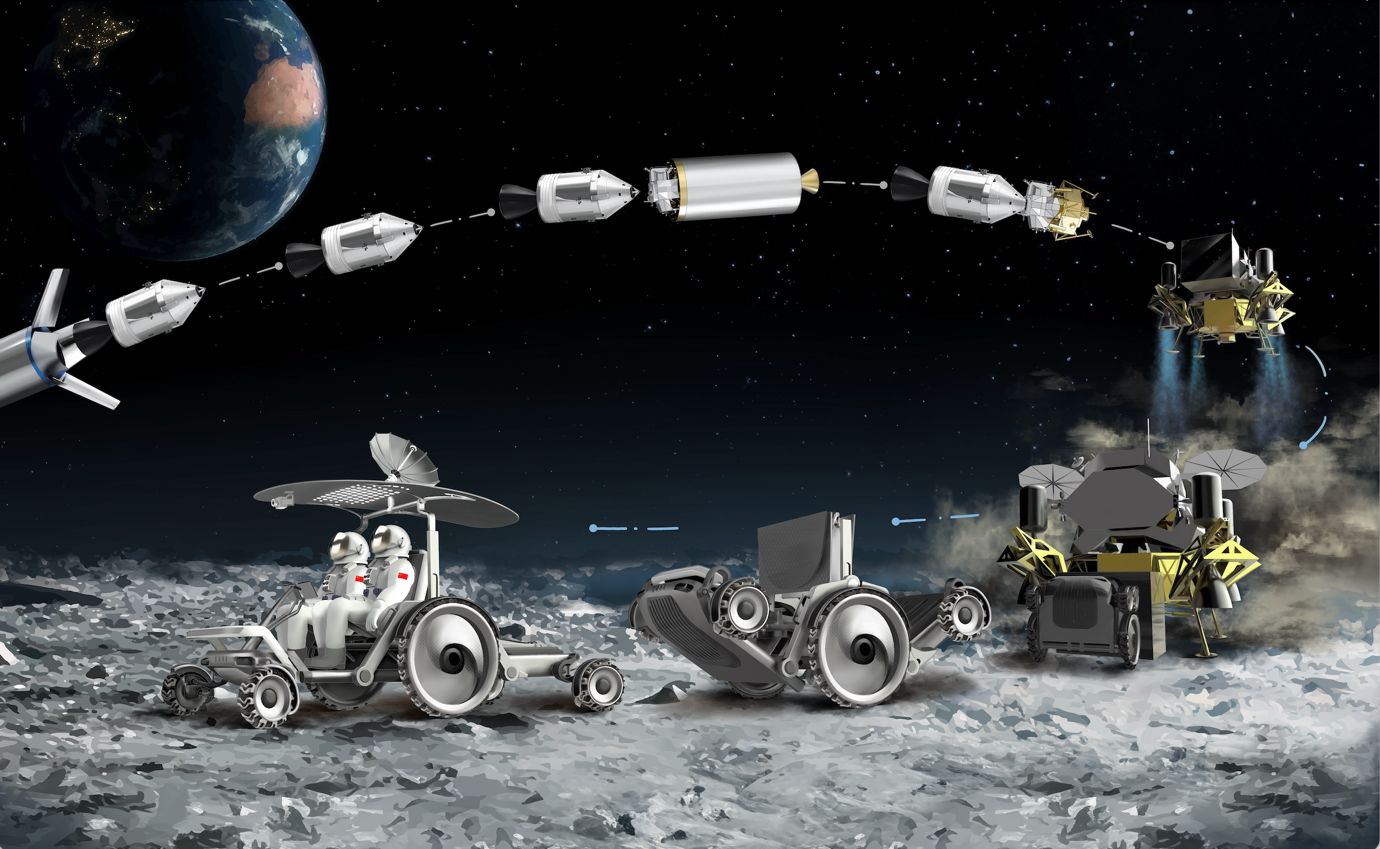A rover and two astronauts are set to traverse the surface of the Moon in a landmark mission set to take place before 2030.
The China Manned Space Engineering Office says the country is on track to put a pair of astronauts on the Moon before 2030 — the first people to do so since the United States’ Apollo 17 mission in 1972.
A Tsinghua-led team has proposed a uniquely Chinese rover that has drawn inspiration from bronze statues of historic Chinese horse-drawn chariots.

The Wangshu Chariot rover has been designed to fold into a compact and lightweight shape for decent onto the Moon’s surface. If selected for a planned 2030 mission, the rover would then unfold and help carry astronauts on the first manned mission to the Moon since 1972.
A chariot for astronauts
In 2017, a Tsinghua-led design team put forward its first version of the manned lunar rover to the CMCA. The primary design looked futuristic — “like science fiction”, says Gantie Zheng, a professor from the Aerospace Eningeering Department at Tsinghua University, who jointly led the rover design team, alongside a number of professors from other departments at Tsinghua. But when the agency officially called for new designs in 2023, the Tsinghua aerospace engineer says they decided to submit something that had more ‘soul’.
The name of the rover comes from Chinese legend — Wangshu is the goddess that drives the chariot for the Moon. Its design draws from highly detailed bronze statues of horse-drawn chariots unearthed from the tomb of Qin Shi Huang — who proclaimed himself the first emperor of China in 221 BCE. The chariots are among the thousands of often life-sized or larger statues, including the terracotta warriors, that were found buried outside of the city of Xi’an in central China.
Unlike traditional two-wheeled chariots, the rover design has six wheels, as well as special braking and ground detection features, for motorised agility. It has two much larger wheels for stability over rough terrain, similar to a chariot, says Song Qiu, a professor from Industrial Design Department of Tsinghua University. The current design also features a canopy reminiscent of the umbrella seen on top of some of its ancient inspirations. “We wanted to introduce traditional Chinese cultural elements into the design,” he explains.
Of course, the rover team used advanced technical features such as very light-weight materials, an incredibly compact fold out design, and the canopy, although reminiscent of ancient times, has a very practical purpose on the Moon.
The research team calls the canopy the ‘baldachin’, which were the canopies often draped above thrones. This one, like on Earth, is used to block the sun’s radiation. But the Moon doesn’t have the same protective atmosphere as Earth and surface temperatures can reach above 257 degrees Fahrenheit (125 degrees Celsius), which is above boiling point.
The rover and astronauts will endure six hours of this kind of heat to complete the planned mission. So, the broad thin canopy on the rover incorporates a cooling system and helps creates a wide shadow area, says Zheng. He explains that temperatures can also drop to -343 degrees Fahrenheit (-173 degrees Celsius) when the sun is not out, but the rover will only be deployed for one journey of six hours in daylight.
The canopy also serves a dual function as an anti-roll feature, as it is supported by a pair of strong columns with a beam on top. Similar to the way an open-roof sport car sometimes features a ‘roll bar’, if the rover tips this bracket will make rolling harder and help protect the astronauts inside from being crushed.
Longer for more payload
One of the greatest challenges was the strict weight and compact size requirement for the payload that would make the decent onto the Moon’s surface from space. “Therefore, we devoted a huge amount of effort into designing a folding and deploying mechanisms,” explains Zheng.
To reduce the weight of the vehicle to the requisite 440lbs (200kg), but allow it to survive the extreme lunar surface environment, some cutting-edge materials were specially designed, such as aluminium and ceramic matrix composites, which are light-weight but strong. Zheng explains that these efforts were rewarded with a large-sized rover that is significantly longer than other eleven submitted designs, and hence has more carrying capacity for the scientific equipment on the back.
The design team have also developed AI driving technology that allows manual, autonomous and a hybrid of human and machine driving. The rover will have traverse-range is about 6.2 miles (10 kilometres). For driving ease, the team have reinvented a joystick. “The philosophy of the new joystick design is to decouple it’s use from needing a detailed feeling of direction, as an astronaut is wearing thick and inflexible gloves,” explains Zheng. “Thus, instead of the conventional round head of a standard joystick, the new head is designed as a beam the width of a space suit glove with bumps at two ends for stability and grip.”

A team at Tsinghua have been developing the ‘Wangshu Chariot’ rover since late 2023.
Moon hops
The rest of the mission, which was originally announced in July 2023, is also moving along in leaps and bounds. The launch, it was announced, will involve three astronauts, who will make the journey to the Moon’s orbit. Only two, however, will descend to the lunar surface with the rover. This pair will then spend six hours collecting data, including the lunar rock and loose stone and dust samples, before rejoining their colleague in lunar orbit and returning to Earth.
The names of the spacecraft and lander were revealed in February 2024. The ‘Mengzhou’ spacecraft has already undergone its first uncrewed test flight in 2020 and was designed as a reusable spacecraft with a modular design that allows it to be constructed to meet different mission demands.
Mengzhou will be launched into space using an existing Long March 10 rocket, which is currently undergoing late-stage testing. And the lunar lander ‘Lanyue’ and the lunar landing suits are also all near complete, according to an announcement made by Lin Xiqiang, deputy director of China Manned Space Engineering Office in April 2024.
New launch infrastructure required to facilitate the mission is being built near China’s existing coastal spaceport on Hainan Island, off of southern China.
If the Wangshu Chariot is selected to be sent on the moon, it will be fabricated in the next few years and tested in remote and space-like environments in conjunction with China Academy of Space Technology.
Editor: Guo Lili